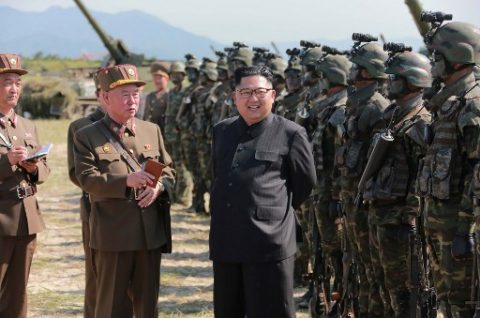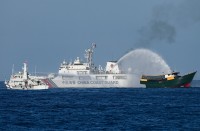
North Korea fired three short-range ballistic missiles on August 26, the US military said, following weeks of heightened tensions between Washington and Pyongyang. / AFP / KCNA via KNS /
SEOUL, South Korea — North Korea said it detonated a hydrogen bomb designed for a long-range missile on Sunday and called its sixth and most powerful nuclear test a “perfect success,” sparking world condemnation and promises of tougher United States sanctions.
Pyongyang residents threw their arms aloft in triumph as a jubilant television newsreader hailed the “unprecedentedly large” blast.
It “marked a very significant occasion in attaining the final goal of completing the state nuclear force,” she added.
But world reaction was swift and angry.
US President Donald Trump said on Twitter Pyongyang’s “words and actions continue to be very hostile and dangerous to the US.”
The US leader refrained from direct threats but branded the North “a rogue nation which has become a great threat and embarrassment to China, which is trying to help but with little success.”
South Korea, Trump added, “is finding, as I have told them, that their talk of appeasement with North Korea will not work, they only understand one thing!”
The US Treasury Department will prepare a package of sanctions that would “cut off North Korea economically,” said Treasury Secretary Steven Mnuchin.
Hours before the test the North had released images of leader Kim Jong-Un at the Nuclear Weapons Institute, inspecting what it said was a miniaturized H-bomb that could be fitted onto an intercontinental ballistic missile (ICBM).
China, the North’s sole remaining major ally, issued a “strong condemnation” of the test, which overshadowed the opening of the BRICS summit in Xiamen by leader Xi Jinping.
Japanese Prime Minister Shinzo Abe described it as “absolutely unacceptable” while Russia’s foreign ministry expressed “strongest condemnation” but urged calm.
In Seoul, President Moon Jae-In called for new United Nations sanctions to “completely isolate North Korea” and said the South would discuss deploying “the strongest strategic assets of the US military.”
That could be taken as a reference to tactical nuclear weapons, which were withdrawn from South Korea by Washington in 1991.
Tremor felt in China
The US and South Korean military chiefs spoke by telephone and agreed the test was “a provocation that cannot be overlooked,” Seoul’s defense ministry said in a statement.
The chairmen of the joint chiefs of staff, General Jeong Kyeong-Doo and General Joseph Dunford, “agreed to prepare a South Korea-US military counteraction and to put it into action at the earliest date.”
US monitors measured a 6.3-magnitude tremor near the North’s main testing site, which South Korean experts said was five to six times stronger than that from the 10-kiloton test carried out a year ago.
The tremor was felt in northeastern China, with people in the border city of Yanji saying they fled their homes in their underwear, and in the Russian Pacific city of Vladivostok.
It was even detected as far away as Germany.
Whatever the final figure for the test’s yield turned out to be, said Jeffrey Lewis of the armscontrolwonk website, it was “a staged thermonuclear weapon” which represents a significant advance.
Chinese monitors said they had detected a second tremor shortly afterwards of 4.6 magnitude that could be due to a “collapse (cave in),” suggesting the rock over the underground blast had given way.
Pyongyang triggered a new rise in tensions in July, when it carried out two successful tests of an ICBM which apparently brought much of the US mainland within range.
Last week it fired a missile over Japan.
Trump has warned Pyongyang that it faces “fire and fury” and that Washington’s weapons are “locked and loaded.”
‘Super explosive power’
Analysts believe Pyongyang has been developing its weapons capability to give it a stronger hand in any negotiations with the US.
“North Korea will continue with their nuclear weapons program unless the US proposes talks,” Koo Kab-Woo of Seoul’s University of North Korean Studies told AFP.
Pictures of Kim at the Nuclear Weapons Institute showed the young leader, dressed in a black suit, examining a metal casing with a shape akin to a peanut shell.
The device was a “thermonuclear weapon with super explosive power made by our own efforts and technology,” the Korean Central News Agency cited Kim as saying, and “all components of the H-bomb were 100 percent domestically made.”
Despite its power there were no radioactive leaks from the test, KCNA said in a later report.
Analysts cautioned that the image had not been verified.
“We don’t know if this thing is full of styrofoam, but yes, it is shaped like it has two devices,” Melissa Hanham of the Middlebury Institute for International Studies in California said on Twitter.
Pyongyang, which insists it needs nuclear weapons to defend itself, carried out its first atomic test in 2006.
Its fifth detonation, in September last year, caused a 5.3 magnitude quake and according to Seoul had a 10-kiloton yield.
The North has been subjected to seven rounds of UN Security Council sanctions over its nuclear and ballistic missile programs, but always insists it will continue to pursue them.





